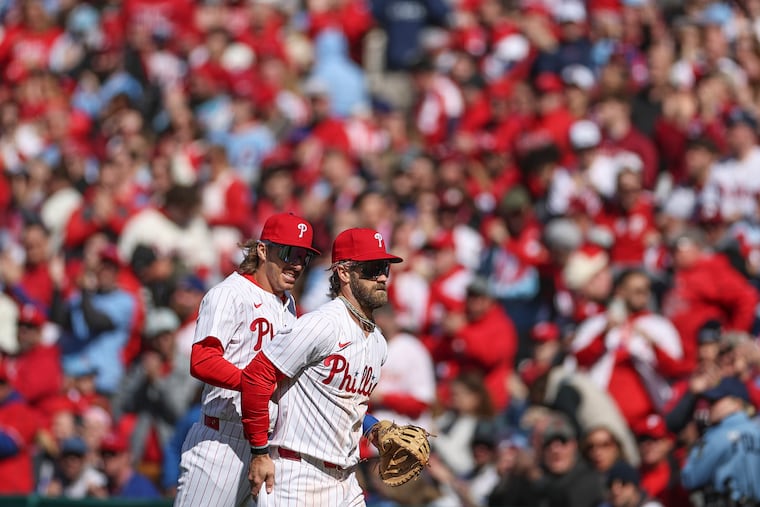Selfless, disciplined Phillies like Bryce Harper and Bryson Stott aren’t chasing as many bad pitches
They're wearing out starters by spitting on balls out of the strike zone and swinging responsibly at strikes. What a concept.

The Phillies are 34-14, their best start since they went to the World Series in 1993. Philadelphians fell in love with that raggedy bunch of misfits because they played hard and smart. Perhaps the most telling statistic of that club’s DNA: It led the National League in walks.
This spring, Phillies hitting coach Kevin Long challenged the 2024 Phillies to practice better discipline at the plate. They’ve listened.
They’re third in walks (with the DH now in the NL, it’s senseless to delineate leagues). They were 16th last season. They’ve seen the fifth-most pitches of any major-league team. They were 10th last year.
Much has been made of the Phillies’ superb starting rotation, which leads baseball with a 2.63 earned run average, and those guys deserve all the attention they’re getting. But the Phillies were built to score. Man, have they been scoring.
» READ MORE: Believe in these Phillies, because that’s the entire point. Bryce Harper agrees (but he gets it)
They started 9-8. They’ve gone 25-6 since. They averaged 3.5 runs in their first 17 games. They’ve averaged 6.3 since.
Why?
Because they’re hitting smart. They aren’t chasing balls out of the strike zone; their “chase rate” has plummeted. They’re making balanced swings and using the entire field. They’re not trying as hard to hit home runs. They’re trusting that the next hitter can produce. They’re making starters work hard early, then making hay late.
“We’re seeing the baseball and not chasing as much — certainly not chasing as much as last year,” said manager Rob Thomson. “Taking our walks. Passing the baton. Everybody knows we’ve got a long lineup, and everybody in the lineup can do damage. It’s a really good offensive approach right now.”
Yes, the Phillies have played some bad teams — only the Braves are above .500 — but they’ve faced some good starters.
Nationals right-hander Trevor Williams entered Sunday’s start with a 1.94 ERA. The Phillies scored three runs in 4⅓ innings, and Williams needed 97 pitches to last that long.
White Sox lefty Garrett Crochet has allowed one or zero runs in five of his 10 starts. On April 19, the Phillies tagged him with seven runs in three innings. He threw 75 pitches.
Padres righty Dylan Cease has allowed two or fewer earned runs in seven of his 10 starts. On April 27 in San Diego, the Phillies hung five runs on him in six innings. He threw 91 pitches.
“It is selfless. It’s each guy understanding that if he puts together a really good at-bat,” Long said, “we can get rid of some pretty good pitchers.”
It’s astonishing how the philosophy has permeated the lineup. The team’s chase rate — the percentage of pitches that are out of the strike zone that a hitter swings at — dropped from 31.3, fourth-worst in baseball, to 28.1, which is the MLB average.
» READ MORE: Phillies’ historic start: Biggest surprises, trade deadline outlook, and are there any concerns about this team?
Many in the Phillies’ regular lineup are even better. Kyle Schwarber and Brandon Marsh were already pretty disciplined, and they’ve stayed steady, setting the example to follow.
Alec Bohm, the team’s best hitter to date, went from 30.0 to 24.5. J.T. Realmuto, having a strong bounce-back season, went from 30.6 to 27.5. Bryce Harper’s down from 33.4 to 30.9. Trea Turner was on his way to a career year before he got hurt, and he’d improved astoundingly, from 35.3 to 26.7. No. 9 hitter Johan Rojas is at 34.9, but that’s five points better than his rookie season.
The club struggled with the concept early in the season. These hitters like to hit, and, with patience in the forefront of their minds, they were taking pitches they should have been hammering. Bryson Stott is hitting .383 with a 1.140 OPS since the beginning of May, when he settled into an aggressively selective groove.
“In spring training we got a little passive,” Stott explained. “When you’re looking to walk, you don’t hit the ones you’re supposed to, and you make yourself late.”
Now, the word is out, Stott said.
“Then the other team’s starter sees our previous games, that starters are throwing 85 pitches by the fourth inning, and they start throwing strikes early,” Stott said. “When they come into the strike zone, we’re getting hits.”
That sounds a lot like those 1993 Phillies, who also led the NL in hits and runs, but there’s a closer comp for Long:
“They’re similar to the Yankees teams that I coached,” Long said.
As Phillies fans know, Long’s 2009 Yankees led all of baseball in home runs, OPS, runs, walks, and, of course, wins … including four World Series wins against the Phillies.